The Earth only seems static and immovable because we live such pathetically short lives. In geologic time, the Earth is always in motion: continents skate and twist, collide and separate, split and suture over millions of years. It's a beautiful, imperceptible dance that never ends.
Starting about 500-550 million years ago, Antarctica, South America, Africa, Madagascar, Australia, the Arabian Peninsula and the Indian subcontinent were part of one large supercontinent called Gondwana. About 180 million years ago, during the Mesozoic era, Gondwana began to break up, eventually resulting in the continental configuration that we all know today.
But how do we know that this is what happened? Much of this story is told through the fossil record of animals and plants that share common genetic traits that can be traced across those continents and sub-continents that were once one large land mass. It's an important story that connects us to our past and the past of our planet and its other species.
The new "Connect the Continents" interactive game is our latest addition to the "Earthquake" exhibit at the California Academy of Sciences. Designed to be a multi-player experience, the game challenges players to reconstruct how the continents and subcontinents of Antarctica, South America, Africa, Australia and India were once connected as the supercontinent Gondwana. Players use five mounted iPads to control one of five of the land masses, swiping and twisting to get their continent to match up with the other ones.
I just watched a group of a dozen tweens playing the game together and they looked very engaged by the experience.
"The orange one is India. The green one is Australia."
"Hey guys, the patterns on the continents help you line them up!"
"Africa, get out of the way!"
"Who has the green state?" "Those aren't states, they are continents!"
"Ooo, we got two of them together!"
I like several aspects of this new interactive. We already have stations in the "Earthquake" exhibit where visitors can see an animation of how the continents have shifted over the millenia, as well as an entire Planetarium show that tells that story. But this interactive game allows the visitor to have an active hand in manipulating and connecting the continents to each other, and share that experience with other visitors doing the same.
The controls are intuitive for anyone who has used any kind of tablet device. And seeing your hand move around one of the big continents on the large screen while others watch is kind of exciting. It's challenging but not impossible, and really does work best with 3-5 people cooperating. It's satisfying to successfully unite two land masses together, and you can see how the fossil record connects them. And at the end seeing the entire Gondwana re-formed at the end as a result of your cooperative efforts gives you a nice sense of accomplishment.
It took the middle schoolers I observed about five minutes to complete the Gondwanan puzzle. As soon as it was done, someone said, "Let's do it again." It looks like "Connect the Continents" will make a fine addition to our "Earthquake" experience at the Academy.
Related Links:
- Exploratorium: Continental Divide interactive timeline.
